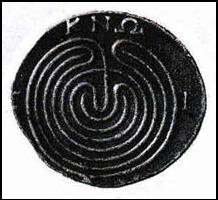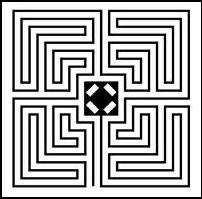




|
Home |
|
Classes |
|
Syllabus / Styles |
|
Biography |
|
Poetry |
|
Photos |
|
Articles |
|
Labyrinths |
|
Storytelling |
|
Artwork |
|
Respects Due |
|
Contact |
|
Links |


|
...with a spirit of self-exploration |

|
Pennine Tai Chi |



|
Mazes and Labyrinths |
|
At the mention of a labyrinth, probably most peoples initial thought would be of the story of Theseus and the Minotaur. At the mention of a maze, the mind might go to the various hedge and puzzle mazes in country estates or within puzzle books. At first sight they may not appear to have much relevance to our everyday life. However, somewhere between the ancient myth and the recreational puzzle, we may find that we are actually surrounded by and encountering such constructs on a daily basis, and in them are contained some of our most powerful inner symbols. How many times do we see in films and television programmes, people being chased through passages and corridors, coming to dead-ends, finding unexpected doors, hiding places or air ventilation shafts to clamber along? The film, if well done, carries us along with the chase and we feel the frustrations, fears and hopes of the participants who are in what is essentially a maze. The same maze – pursuit scenario is often seen in car chases through a labyrinth of city streets, or even forward dated into the space age in films such as ‘Star Wars’. Although mazes and labyrinths have ancient roots, we are encountering them more and more in modern day society. Numerous people become engrossed in computer games that involve navigating mazelike complexes whilst encountering all sorts of adventures in order to arrive at or attain some goal. In ‘Tomb Raider’ the most popular computer game to date, Laura Croft encounters her adventures set in ancient Egyptian tombs. On a more everyday level, when we visit an unfamiliar place (whether it be a modern city or a wild place in nature), it may well appear daunting until we have the guidance of someone who is familiar with the lay of the land or at least a map that has been compiled by someone who knows the ground. Just like entering a maze, the arrival in an unfamiliar place can be a stressful, anxious and/or exciting time, which reawakens one of our greatest childhood (and adult) fears – getting lost. In English, the words labyrinth and maze are generally synonymous and used interchangeably. However, strictly speaking, they are two different things, each with their own characteristics.
LabyrinthsThe distinguishing feature of a labyrinth is that it is unicursal. That is to say that it has a single path that does not have dead ends or false branches. By following it we will cover every part of the path once and once only to arrive at the centre (and in most designs, once on the return journey). On this journey, we may come close to the centre at various points, only to move away from it again. However, by keeping on the journey, following its twists and turns, we will eventually arrive at the centre or goal. As such, the single meandering pathway of the labyrinth can be seen as an analogy for one’s life journey. Although ancient in its origins, the labyrinth was taken on and developed, in the Middle Ages, by the Christian church that perhaps felt a resonerance with the idea of a single pathway to salvation.
MazesThese are defined as having multicursal pathways, which means that there may be numerous routes – both true and false. At various points, we are given a choice of paths and consequently we are likely to encounter many dead-ends. This provides much scope for confusion. Although there are certain methods and strategies that may help us find our way in the maze, there will inevitably be a great degree of uncertainty and luck involved. In such a maze, it is possible to get lost in trying to find the centre, but when the initial euphoria of reaching the goal subsides, we realise that we are likely to have just as much difficulty in orientating our way out again, (unless we used a trail of twine as did Theseus). By putting us under such pressure, the maze may bring forth and reveal different aspects of our character that highlight our ability to cope with the unknown. This is a situation that anyone who has undertaken independent travel will be familiar with. Using the analogy of the journey through life that we equated with the labyrinth, it could be said that the maze may be likened to the feeling of life when we are in the midst of it and just seeing our immediate environment and circumstances. The labyrinth equates more to how we may feel when looking back over a period of our lives and see the bigger picture of how its twists and turns have produced an overall pattern and direction that has brought us to the present.
Symbolic Interpretation
Death and RebirthThe passage to the inner sanctuary of the labyrinth and out again can be seen as symbolic of death and rebirth and hence the labyrinth has been related to the womb and to the tomb. A Christian interpretation may equate this to Christ descending into hell and returning to eternal life. Many labyrinths are known as the ‘Road to Jerusalem’ and the following of their path (sometimes on hands and knees) was seen as representative of this pilgrimage for those unable to undertake the full journey.
Inner WorldsA Jungian perspective may see the journey as one of going within to encounter our shadow side and bringing to the conscious, that which is unconscious. An interpretation of Theseus and the Minotaur could also be seen in the light of an encounter with dark elemental forces whether they be inner or outer. Some folk tales attribute the labyrinth with protecting one from the devil, for he can only travel in straight lines. The Romans appear to have had a similar idea when using a labyrinth design as a protective charm close to doorways.
Goddess and FertilityAnother common thread in labyrinth lore is an association with the goddess, maidens and courtship. It is said that when Theseus escaped from Crete with Ariadne, they stopped on the island of Delos and performed the spiralling movements of the Crane Dance, the steps of which re-enacted the twists and turns of the labyrinth. Ariadne, a princess in the story, was probably originally an ancient goddess figure and the crane dance is a courtship dance, so the story tells of the cross fertilisation of the ancient Greek and Minoan cultures. In Britain, labyrinths were traditionally used in Easter and Mayday celebrations. A maiden, often the May Queen, would wait in the centre whilst youths were timed to find the fastest to the centre. The honour bestowed on the victor was to dance together with the maiden. These celebrations could be seen as having links to ancient fertility rites and thanksgiving for the return of spring.
Some forms that labyrinths and mazes may take. |
|
In the next issue, we will look at how labyrinth design has evolved from early origins in prehistoric rock carvings to its present day sophistication. Also, we will follow through in stages, a method for constructing labyrinths. John BolwellFor many years, John has had a keen interest in reading, researching, drawing, building and visiting labyrinths. He can be contacted by email: spiralmyth@lineone.net
Bibliography The Mystic Spiral by Jill Purce
Labyrinthos is a UK organisation for the study of mazes and labyrinths and publishes an annual journal called Caerdroia. Their website is: www.labyrinthos.net |


|
Design on a coin from Knossos (Crete) |
|
Roman Labyrinth Design |
Labyrinths |
Mazes |
|
· Rock carvings: these are some of the most ancient examples and have been found across many cultures but can be hard to date. |
· Egyptian Pyramids: these reveal the Pharaohs’ obsession with maze-like structures. |
|
· Coins: minted on coins such as those found at Knossos in Crete. (Figure1) |
· City or Fortress Defences: although no archaeological evidence has been found, these have been associated with both Jericho and Troy. |
|
· Stones and boulders: these large walkable labyrinths are particularly prevalent in Scandinavia and have tended to be close to the coast. |
· Hedges: these were particularly popular in Britain during Victorian times. |
|
· Turf: cut out of turf and often on village greens, these are large enough to walk and there have been several in Britain of which there are 8 ancient surviving examples. |
· Lines: as in the type that is in puzzle books to be followed with a pencil. |
|
· Mosaics: popularised by the Romans, these are not usually big enough to walk but could be used for contemplation and as protective amulets at doorway thresholds. (Figure 2) |
· Mirrors: some modern maze designers make mirror mazes to increase the sense of disorientation and confusion. One such maze has recently been constructed in Shanghai. |
|
· Cathedral: such pavement style labyrinths were developed in France in the middle ages and recent years have seen many constructed in America. |
· Maize: a popular trend is to cut mazes into large maize fields that farmers can then turn into a tourist attraction. The overall effect is perhaps not dissimilar to that of corn circles. The British maze designer, Adrian Fisher has been particularly innovative in this field. |